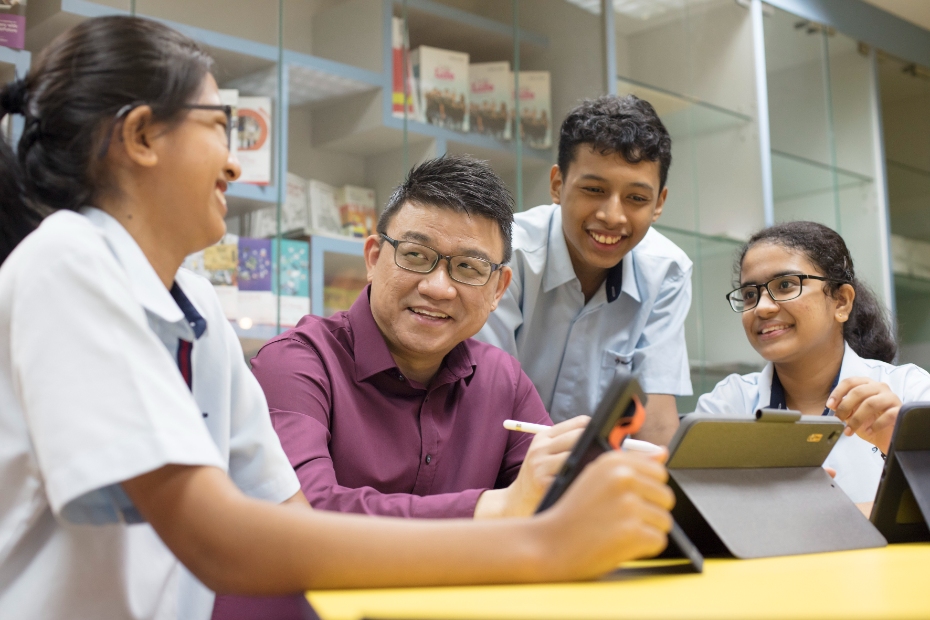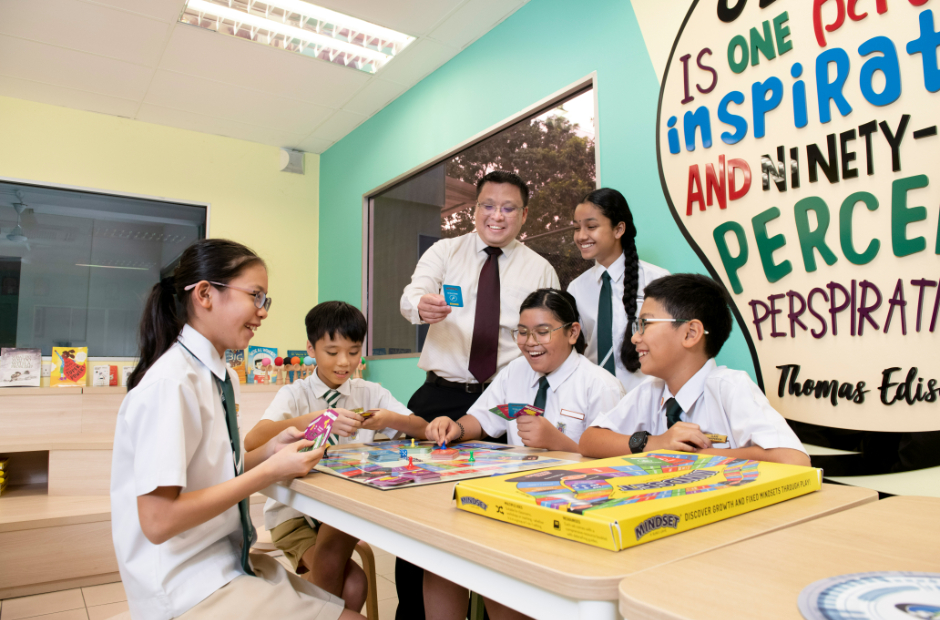Lin Shaojie, Riverside Secondary School, President’s Award for Teachers 2022 Recipient
Inside Riverside Secondary School’s library, an Additional Mathematics lesson was in session. The air was filled with the quiet buzz of conversation as 40 Secondary 3 students worked on some mathematics equations.
Working on their Personal Learning Devices (PLDs), the students moved seamlessly between different applications to extract data, analyse trends, construct theories and develop concepts. Occasionally, teacher feedback popped up virtually, to guide without giving away the answers.
Seated beside some of the students and observing them first-hand were UK experts from the Cambridge University Press and Assessment; the educators were on a learning trip to Singapore, hosted by the Singapore Examinations and Assessment Board.
“It was an honour to share how teaching and learning takes place in a one-to-one learning environment, with seamless interactions between my students and me, and their thinking made visible to everyone in the class via technology”, recalls Lin Shaojie, Lead Teacher in Mathematics at the school. He also recalls how happy he was that his lesson on Euclidean geometry went well. The students not only managed to crack the equations in the time given, but they could also explain confidently to the guests their groupwork routines and share their thought processes. “I felt so proud of them,” he says without hesitation.

Levelling the field through technology
What has been exemplary about Shaojie’s classes is how the delivery of each Maths topic is thoughtfully planned with the students’ learning needs in mind, including selecting suitable ICT learning tools and a right blend of assessment-feedback practices to engage and guide them along.
For every lesson to pack a punch, Shaojie starts by sparking curiosity and clarifying the lesson’s success criteria – what exactly the students need to learn and demonstrate by the end of the lesson.
By that, he is not just referring to the syllabus but what each student should take away in relation to that syllabus. He personalises his teaching. Shaojie creates check-in lists to elicit students’ prior knowledge, and actively monitors his students’ responses and assignments to check understanding. He also gives specific feedback both in real-time observations in class and online. Questions are included at the end of his worksheets for students to reflect on their own learning, and as a reflective practitioner, Shaojie also includes questions for his students to indicate the usefulness of his feedback to them.
This is where ICT comes in as a transformative tool, Shaojie explains.
At each lesson, he uses an app as a digital whiteboard to share his mathematical workings in real time with his students. He also captures screenshots of the students’ work done on their iPad to use as exemplars to affirm good work and address any learning gaps. Shaojie also records his lessons and his interactions with students in real time using another app and uploads these videos. Students can access these videos anytime, anywhere for their own revision.
“Teachers must realise we are making a difference in our students’ lives every day. Every decision we make – how we deliver content, the way we design lessons, the way we talk to them – must maximise the chance of success for each and every child.”
In so doing, students who have difficulty in grasping certain topics or concepts can revisit past lessons to revise at their own pace. As the classroom interaction between him and the students is captured on the fly as the lesson progresses, students can visualise the concepts easily and follow the explanations independently.
The motivation behind Shaojie’s efforts is student-centricity and an effort to promote students’ metacognition. He wants the students to think about their own thinking and to take ownership of learning. With 1:1 learning, he is able to place the power of learning in each student’s hands, with students actively monitoring their own progress according to their own learning pace and ability. Thus, this could level the playing field for them.
He used to scold his students for giving up
To Shaojie, getting a child to learn goes beyond the classroom – he wants to address their affective needs, which is why he puts himself in his students’ shoes to see things from their perspectives.
He says, “The biggest challenge for me is when my students say something is too difficult and they give up. I used to scold them for giving up without trying, but when I reflected on this, I saw that I was just shifting the responsibility of their learning away.”
Setting assignments and tests on content that they were already struggling with also only served to reinforce their doubts about their own abilities. He decided to take a different tack – by reshaping their self-beliefs and helping them build small successes, one Maths problem, one assignment, and one test at a time.
Instead of using the traditional drill-and-practice approach to Maths learning, he diagnosed the root causes of his students’ learning problems and addressed those gaps. He broke down mathematics concepts into parts, and carefully designed scaffolds in his teaching and learning materials to help his students build up their understanding part by part. Eventually, his students picked up the concepts and learnt mathematical reasoning skills. They gained confidence in their ability to apply his feedback and problem-solve more effectively, and the impact is evident in their fluency in and love for mathematics.
Giving more than just a second chance
Another secret to Shaojie’s effectiveness is not technology nor pedagogy but his ability to connect with students very well.
“They know I will always be there for them,” he says of his students, especially those who misbehave in class. “With me, they will always get a second, third, or fourth chance. I go all the way because I want them to enjoy the class. I want them to understand that learning must continue no matter the circumstance.”
Some years ago, Shaojie started the semester with a Secondary 3 student who had anger management issues. He was aggressive to the point of hurting his friends emotionally and physically. There were many unaddressed emotional issues. To build bridges, Shaojie made it a point to meet him every morning, to speak with him, but the boy just ignored him. Shaojie persisted and sat with him quietly, with no judgement made andt just offering a listening ear.
By the end of one semester, the boy warmed up to Shaojie and opened up. He took Shaojie’s advice – to think first before he acts and to learn to control his impulsivity. He also thought about his purpose in life and how he wanted to spend his time. Gradually, he learnt to control his temper and presented fewer issues in school. Two years later, he graduated as the top student in his Secondary Five cohort and secured a place to study Nursing – the polytechnic course of his choice. So grateful was the boy and his parents for Shaojie’s efforts that they nominated him for the President’s Award for Teachers.

Shaojie’s ability to connect with his students has not gone unnoticed by his school leaders. In 2018, he was appointed as the school’s Special Educational Needs (SEN) champion, a role he cherished as he set out to create a caring and inclusive community around his charges.
This coincided with Riverside Secondary School’s move to a Full Subject-Based Banding pilot school, where students with diverse learning needs were distributed across all classes. With greater awareness of SEN, more colleagues also sought out Shaojie for his advice and learning support tips. He guided them to do differentiated instruction and how to leverage on technology for assessment for learning.
Together with his school’s Allied Educator for Learning and Behavioural Support and his fellow teachers, Shaojie put his planning prowess to work – to ensure the SEN students could enjoy the same opportunities as every other student in their class.
For wheelchair-bound students, for example, the teachers were intentional about meeting their needs, carefully thinking through and planning for their access needs, addressing specific learning issues as well as building confidence. This could include arranging for an extra seat for a chaperone in class, and even factoring in more time for travelling so they have the time they need to join in an activity.
Assessment is thinking about what the students need
For Shaojie, teaching is the visible aspect of his commitment to his students. What goes on behind the scenes is knowing each student and how he designs the learning experience for the students.
His deep expertise and passion in pedagogy and assessment – his colleagues recount in admiration how he has devoured over a hundred books on this area – led to his leading role in his school’s Professional Development (PD) team and a role model to emulate.
Shaojie generously shares his ideas and resources and conducts many PD sessions for his colleagues. He takes the same empathetic approach he has for students with the adult learners too. He engages his colleagues in dialogue and is acutely aware that teachers have diverse PD needs. For teachers to see the relevance of his sharing, Shaojie often role models for them and invites them to be his critical friends.
Recently, he posed this question to the PD team in the school he is leading: How can we think more about what assessments can do for students’ learning and less about what students should do for assessments? It captured the imagination and led to a mindset change and a number of refinements in existing lessons, because the student is placed first before planning for activities and assessment tasks.
“Teachers must realise we are making a difference in the students’ lives every day,” he stresses, his quiet demeanour brimming with sincerity. “Every decision we make – how we design lessons to help students achieve the learning goals, how we ensure students learn not just the content but in the process, acquire the love of learning for the subject and the necessary 21st century skills, and how we talk to them to encourage their minds and hearts – must maximise the chances of success for each and every one of them.”






